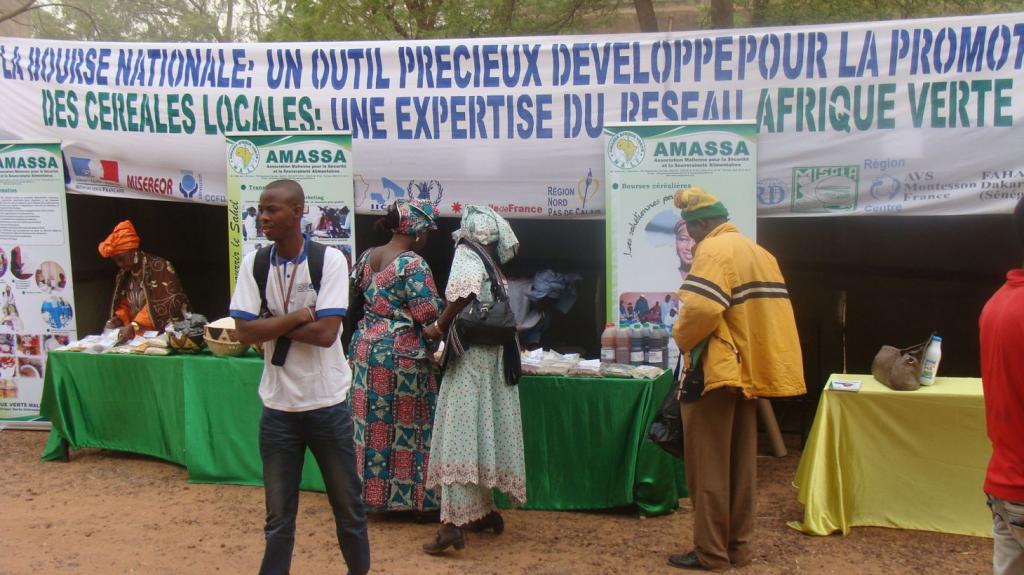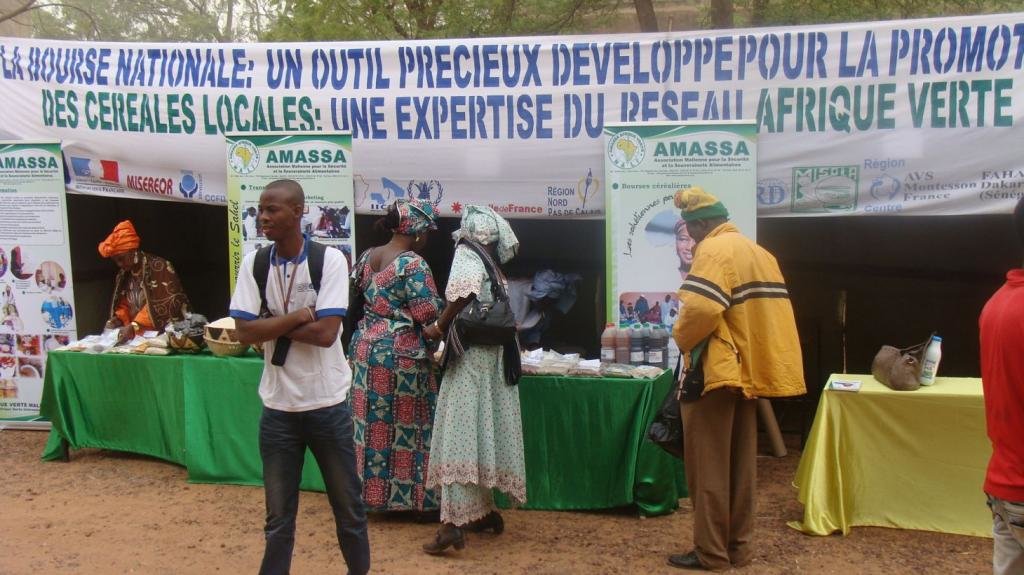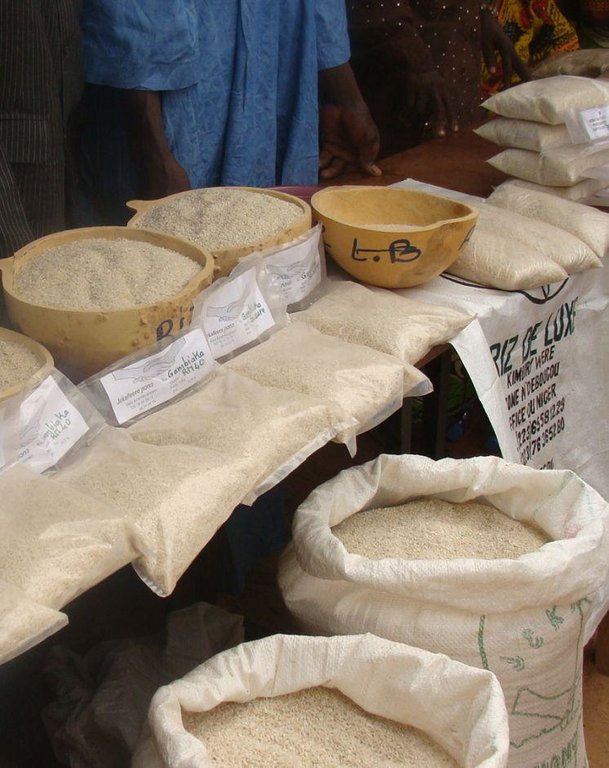Grain exchanges [马里]
- 创建:
- 更新:
- 编制者: Dieter Nill
- 编辑者: –
- 审查者: Laura Ebneter
Bourses aux céréales (French)
approaches_2511 - 马里
查看章节
全部展开 全部收起1. 一般信息
1.2 参与方法评估和文件编制的资源人员和机构的联系方式
SLM专业人员:
Haidara Mohamed
afriqueverte@afribone.net.ml
AMASSA - Afrique Verte Mali
马里
SLM专业人员:
Ballo Yacouba
capi@afribone.net.ml
AMASSA - Afrique Verte Mali
马里
有助于对方法进行记录/评估的机构名称(如相关)
Deutsche Gesellschaft für Internationale Zusammenarbeit (GIZ) GmbH (GIZ) - 德国有助于对方法进行记录/评估的机构名称(如相关)
L'Association Malienne pour la Sécurité et la Souveraineté Alimentaires - Afrique Verte Mali (AMASSA - Afrique Verte Mali) - 马里1.3 关于使用通过WOCAT记录的数据的条件
(现场)数据是什么时候汇编的?:
01/07/2012
编制者和关键资源人员接受有关使用通过WOCAT记录数据的条件。:
是
2. SLM方法的描述
2.1 该方法的简要说明
Link up production areas with the areas where grain is consumed in order to encourage the flow of cereals from one area to the other
2.2 该方法的详细说明
该方法的详细说明:
The objective of grain exchanges is to link up production areas with the areas where grain is consumed in order to encourage the flow of cereals from one area to the other. In this way, the
exchanges contribute to stabilising market prices and informing cereal producers about how these markets function.
The support structure (AMASSA – Afrique Verte Mali, a body devolved from the French NGO
Afrique Verte) invites producers and buyers to participate in a two to three-day grain exchange. This process of connecting up parties allows producers to assess grain production levels for the current season and buyers to get an idea of the grain stocks available. The two parties then negotiate grain quantities and prices. A good number of contracts are agreed during the exchange, and the agreement of further contracts after the exchange is likely. The exchange also serves to foster exchange among other actors involved in the sale and production of grain.
Organising exchanges involves several stages: First, supplies are identified in areas with high levels of dry cereal production (millet, sorghum and maize in the Sikasso, Koutiala, Ségou, Senon de Koro/Bankass plains) and rice production (in the Niono rice growing region in the Office du Niger). At the same time, the needs of consumption areas (supply cooperatives in Kayes Region and grain banks in the areas of Gao, Timbuktu and Kidal) and major consumption centres with processing plants, merchants and consumer cooperatives (such as Bamako) are identified. The supply cooperatives from rice-deficit areas (the Kayes area, for example) are identified and their needs recorded (bulk purchasing requests). Producers’ associations in the Niono region in the Office du Niger area are identified and their rice surpluses ascertained. Supplies for sale are then quantified and stockholders are encouraged to put together a bulk sales offer. Finally, a meet-and-greet workshop is held to foster exchange and discussion on grain supply and demand.
Role of stakeholders: AMASSA – Afrique Verte Mali catalogues and groups offers (purchase or sale) and cereal requirements during the pre-exchanges, and promotes the exchange among relevant cereal operators (advertising). AMASSA also provides financial and technical support in organising the exchange (venue hire, refreshments). Supply cooperatives and private operators support the process of identifying cereal requirements prior to the exchange and then participate in the exchange itself. Their role is to buy stock. Producers’ associations communicate how much of their stock is available and trade this in bulk at the exchange. The legal advisor helps draw up the sales contracts and explains the content of sales contracts to operators. Others, such as technical partners in the sector (Planning and Statistical Unit of the Ministry of Agriculture, DNSI, OMA, OPAM, Customs Service, EWS, WFP, National Agency for Food Safety and Security, etc.), provide additional specific information.
The transactions carried out in the exchanges are fairly advantageous both for the sellers (producers and their organisations) and the buyers (merchants, supply cooperatives, consumer cooperatives, processing outfits). These advantages can be measured in terms of price and quality. The grain exchanges are prized by many actors and an increasingly large number of structures have built them into their support mechanisms. The farming profession is interested in this approach. For this reason, the exchanges are increasingly being jointly delivered by APCAM and often by the Association of Professional Farming Organisations (AOPP) and projects and/or NGOs. The fact that the farming profession is appropriating the exchange concept bodes well for its sustainability.
2.3 该方法的照片
2.5 采用该方法的国家/地区/地点
国家:
马里
区域/州/省:
Mali
有关地点的进一步说明:
Niono, Koutiala, Sévaré-Mopti, Ségou, Kayes
2.6 该方法的开始和终止日期
注明开始年份:
1995
2.7 方法的类型
- 基于项目/方案
2.8 该方法的主要目的/目标
The objective of grain exchanges is to link up production areas with the areas where grain is consumed in order to encourage the flow of cereals from one area to the other. In this way, the exchanges contribute to stabilising market prices and informing cereal producers about how these markets function.
The SLM Approach addressed the following problems: weak link of production areas with the areas where grain is consumed, unstable market prices
2.9 推动或妨碍实施本办法所适用的技术的条件
其他
- 阻碍
weak link of production areas with the areas where grain is consumed
Treatment through the SLM Approach: The support structure AMASSA – Afrique Verte Mali invites producers and buyers to participate in a two to three-day grain exchange. This process of connecting up parties allows producers to assess grain production levels for the current season and buyers to get an idea of the grain stocks available. The two parties then negotiate grain quantities and prices. A good number of contracts are agreed during the exchange, and the agreement of further contracts after the exchange is likely.
3. 相关利益相关者的参与和角色
3.1 该方法涉及的利益相关者及其职责
- 当地土地使用者/当地社区
- SLM专家/农业顾问
- NGO
- 地方政府
- 国家政府(规划者、决策者)
3.2 当地土地使用者/当地社区参与该方法的不同阶段
| 当地土地使用者/当地社区的参与 | 指定参与人员并描述活动 | |
|---|---|---|
| 启动/动机 | 被动 | |
| 计划 | 互动 | |
| 实施 | 互动 | |
| 监测/评估 | 互动 | |
| Research | 被动 |
3.4 有关SLM技术选择的决策
具体说明谁有权决定选择要实施的技术:
- 主要是土地使用者,由SLM专家提供支持
解释:
Decisions on the method of implementing the SLM Technology were made by mainly by SLM specialists with consultation of land users
4. 技术支持、能力建设和知识管理
4.1 能力建设/培训
是否为土地使用者/其他利益相关者提供培训?:
是
明确受训人员:
- 土地使用者
培训形式:
- 在职
- 农民对农民
- 公开会议
涵盖的主题:
Before each workshop, facilitators from AMASSA – Afrique Verte Mali ascertain the grain needs of consumer regions in order to bulk together orders to the different supply cooperatives and grain banks. Likewise, producers’ available grain stocks are ascertained and bulked to build a substantial supply. To ascertain the needs of the parties involved, AMASSA – Afrique Verte Mali organises forums in the main production areas called ‘pre-exchanges’. These pre-exchanges are, in effect, regional preparatory meetings where around 80 to 100 people come together to assess the offers available and the approaches for bulking supply and demand.
In addition, facilitators use the pre-exchanges to train organisations in market negotiation techniques, price setting and drawing up sales contracts. An area of particular focus is the content of contracts (delivery deadlines, quality and standards to be delivered, quantities, packaging requirements, etc.) and the consequences of failing to meet the terms of the contract. A series of pre-exchanges are rolled out in different locations.
In practice, the exchanges serve as platforms for information exchange that give operators the opportunity to get up to speed with certain key aspects of the trade. They provide information on the status of cereal production, areas facing food scarcity or economic difficulties, cereal price trends, legislative and regulatory procedures relating to cross-border trade, invitation to tender opportunities for replenishing the National Security Stock (SNS) and sales of intervention stocks. This range of information is essential and enables operators to better position themselves in the grain market.
4.2 咨询服务
土地使用者有权使用咨询服务吗?:
是
说明/注释:
Advisory service is quite adequate to ensure the continuation of land conservation activities
4.3 机构强化(组织发展)
是否通过这种方法建立或加强了机构?:
- 是,适度
具体说明机构的强化或建立程度:
- 本地
具体说明支持类型:
- 财务
- 能力建设/培训
4.4 监测和评估
监测和评估是该方法的一部分吗?:
是
注释:
economic / production aspects were regular monitored by project staff, land users through measurements
management of Approach aspects were regular monitored by project staff, land users through observations
There were no changes in the Approach as a result of monitoring and evaluation
There were no changes in the Technology as a result of monitoring and evaluation
4.5 研究
研究是该方法的一部分吗?
是
明确话题:
- 经济/市场营销
5. 融资和外部物质支持
5.1 该方法中SLM组成部分的年度预算
注释(例如主要的资助来源/主要捐助者):
Approach costs were met by the following donors: national non-government: 100.0%
5.2 为土地使用者提供财政/物质支援
土地使用者是否获得实施该技术的财政/物质支持?:
否
5.3 对特定投入的补贴(包括劳动力)
如果土地使用者的劳动力是一项重要的投入,那么是不是:
- 自愿
5.4 信用
是否根据SLM活动的方法给予信用值?:
否
6. 影响分析和结论性陈述
6.1 方法的影响
该方法是否帮助土地使用者实施和维护SLM技术?:
- 否
- 是,很少
- 是,中等
- 是,支持力度很大
Product quality improves and becomes more standardised
该方法是否有助于社会和经济弱势群体?:
- 否
- 是,很少
- 是,中等
- 是,支持力度很大
Did other land users / projects adopt the Approach?
- 否
- 是,很少
- 是,中等
- 是,支持力度很大
AMASSA – Afrique Verte Mali began operations in Mali in 1994 and the first exchanges took place in 1995. AMASSA – Afrique Verte Mali organises several exchanges each year in Mali: One exchange in Niono to supply Kayes Region and urban centres like Bamako with rice from the surplus area of Office du Niger. This exchange only involves parties interested in trading rice. One exchange in Koutiala in South Mali to supply regions in the north of Mali (Gao, Timbuktu and Mopti) and major consumption centres in Bamako with dry cereals (particularly maize, millet and sorghum derived from the surplus area of Sikasso). One exchange in Sévaré-Mopti to supply regions in the north of Mali (Gao, Timbuktu and Mopti) with dry cereals (particularly millet and sorghum derived from the surplus area of the Séno de Koro plains). One national exchange in Ségou involving all national cereal operators (producers, farmer organisations, cereal processing plants, cereal merchants, logistics companies, institutional market structures and technical partners). This exchange involves all tradable cereals (rice, millet, sorghum, maize, fonio and others). Two regional exchanges within the Kayes region (Kita and Diéma). These exchanges enable deficit areas to source dry cereals regionally in Kita and Diéma. Kita and Diéma are considered surplus areas in the Kayes region. One international exchange that involves several countries. The last international exchange was organised on 13 and 14 December 2011 in Bamako with nine ECOWAS countries participating. The exchange resulted in the sale of 50,000 tonnes of grain for more than 8 billion CFA francs. The international exchange involves 200 participants and the trading of 50,000 tonnes of grain between cereal operators from participating countries. The exchanges are increasingly being jointly delivered by APCAM and often by the Association of Professional Farming Organisations (AOPP) and projects and/or NGOs. Grain exchanges have attracted the interest of many actors in the cereals sector. Interest is so high that a host of organisations have expressed the desire to hold their own grain exchanges (e.g. chambers of agriculture, cereals sector support projects and programmes, decentralised authorities).
Did the Approach lead to improved livelihoods / human well-being?
- 否
- 是,很少
- 是,中等
- 是,支持力度很大
The exchanges help producers and consumers agree preferential prices without the need for intermediaries with the aim of reducing the cost of cereals in consumer areas and increasing it in production areas. Product quality improves and becomes more standardised, regular interaction increases client loyalty, and there is greater structuring of producers and consumers.
Did the Approach help to alleviate poverty?
- 否
- 是,很少
- 是,中等
- 是,支持力度很大
Each exchange in Niono, Sévaré-Mopti, Koutiala involves between 70 and 80 participants, representing nearly 120 villages. The transactions effected are viable. Niono exchange: between 2,000 and 3,000 tonnes per year; Sévaré-Mopti exchange: between 800 and 1,500 tonnes per year; Koutiala exchange: between 1,500 and 2,500 per year.The Diéma and Kita exchanges involve around 50 people, with around 80 to 120 tonnes of cereals sold at each yearly exchange. The yearly Ségou national exchange involves around 150 to 200 operators in the cereals sector. 9,000 to 15,000 tonnes of cereals (millet, sorghum, maize and fonio) are sold at the event each year.
6.2 土地使用者实施SLM的主要动机
- 增加生产
- 增加利润(能力),提高成本效益比
6.3 方法活动的可持续性
土地使用者能否维持通过该方法实施的措施(无外部支持的情况下)?:
- 是
6.4 该方法的长处/优点
| 编制者或其他关键资源人员认为的长处/优势/机会 |
|---|
|
The exchanges help producers and consumers agree preferential prices without the need for intermediaries with the aim of reducing the cost of cereals in consumer areas and increasing it in production areas. Product quality improves and becomes more standardised, regular interaction increases client loyalty, and there is greater structuring of producers and consumers. For example, the apex organisations in Niono (20 rice grower organisations collectively called ‘Jèka Feeré’) and in Yalimenané (28 supply cooperatives collectively called ‘Supunu Kafô’) have been set up as a result of the exchange system. (How to sustain/ enhance this strength: Successful exchanges require: 1) the organisation of producers and buyers to increase supply and demand; 2) bulk purchasing approaches to secure lower prices; 3) the formalisation of purchase contracts and cereal logistics; 4) the origins of merchandise to be traceable; 5) contractual agreements to be respected in terms of quality, payment methods and deadlines, delivery deadlines and methods, etc.) |
| The exchanges enable people working in the sector get to know the main challenges in trading cereals. They therefore constitute a suitable framework for advocacy activities (advocacy platform) where actors involved in the sector have the opportunity to communicate directly with leading figures in the sector and to defend their interests in terms of the production and sale of cereals. |
|
grain exchanges have attracted the interest of many actors in the cereals sector. Interest is so high that a host of organisations have expressed the desire to hold their own grain exchanges (e.g. chambers of agriculture, cereals sector support projects and programmes, decentralised authorities). Currently, exchanges – in particular, the national grain exchange – are jointly delivered by AMASSA – Afrique Verte Mali and the Permanent Assembly of the Mali Chambers of Agriculture (APCAM). (How to sustain/ enhance this strength: The critical factor in making these exchanges genuinely successful is ensuring their sustainability, i.e. ensuring that their main beneficiaries (producer organisations, processing outfits, cooperatives, grain banks, merchants and animal food manufacturers) take financial and political ownership of the exchanges. Beneficiaries across the board recognise that the tool is useful and necessary. But how, with what means and when will these parties take over the organisation of exchanges and cover all the costs involved (organisation, facilitation, technical support)? It remains to be seen how these actors will be able to take on this responsibility in the short or medium term given the frequently low incomes among producer organisations, and particularly among those in rice-deficit areas. On the other hand, it is certainly possible over the medium term to maintain partial ownership and to foster a gradual shift towards ownership by producer organisations and operators through the progressive increase of their contributions. Setting up partnerships involving support for organisations and programmes operating in the sector is also a viable option. The sustainability of this approach depends on it being fully appropriated by the beneficiaries themselves, so that AMASSA – Afrique Verte Mali becomes merely a provider of technical know-how.) |
6.5 该方法的弱点/缺点以及克服它们的方法
| 编制者或其他关键资源人员认为的弱点/缺点/风险 | 如何克服它们? |
|---|---|
| a certain level of expertise is required to organise and run the exchanges in a way which ensures they deliver all their desired outcomes |
7. 参考和链接
7.1 方法/信息来源
- 实地考察、实地调查
- 与土地使用者的访谈
7.2 参考可用出版物
标题、作者、年份、ISBN:
Manual of Good Practices in Small Scale Irrigation in the Sahel. Experiences from Mali. Published by GIZ in 2014.
可以从哪里获得?成本如何?
http://star-www.giz.de/starweb/giz/pub/servlet.starweb
标题、作者、年份、ISBN:
Afrique Verte activity reports
标题、作者、年份、ISBN:
Find out more at: www.afriqueverte.org
链接和模块
全部展开 全部收起链接
无链接
模块
无模块




